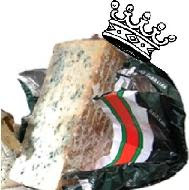
We’ve been calling our Valdeon by the name Cabrales; we’ve seen the error in our ways and now we’re casting a limelight on the rivalry...
Cabrales has become synonymous with blue-cheese-from-the-North-of-Spain. It's the name that came with the burgeoning specialty, imported cheese market in the early 1990s. The name clung to the style like a foil wrapper on the sticky blue cheese rind. At the time, the name was more of an importing alias than what some could interpret now as a false front. It seems that as we enter Act II of America’s fascination with fine cheese, the specifics are of growing importance.
Truly,
Valdeon and
Cabrales are two distinct cheeses, but there are some strong similarities lending to a history of interchangeability: The mixed milk (mostly cow, with additions of sheep and goat’s milk depending on the season), the rich blue veining within medium sized wheels, and the sharp and hefty flavors.
If it helps, think of Valdeon as a theatrical understudy to the more famous Cabrales. In effect, many have kept the headliner on the marquis, but have chosen to open with the alternate, who boasts consistent performances and a younger more handsome visage. Valdeon just seems to be a little easier on the eyes, palate and pocketbook.
It’s like how Isadora Duncan rose to fame under the tutelage of legendarily esoteric Loie Fuller, only to rebuke her influence during the peak of her own celebrity. A striving Valdeon just wants the credit due for his own achievements, yo.
It’s become clear that one name ‘Cabrales’ doesn't capture the whole story. There are several cheeses from the area, each with their own distinct protected designation of origin (DO), subtle variations of flavor and enormous distinctions in texture and appearance.
Here are the clear differences between these two:
Specific locale.
Valdeon is made in Castille-Leon, while
Cabrales hails from the magical
island of Asturias.
Valdeon tends to have a smoother quality to its flavor profile, and a more uniform color and texture.
Cabrales is a little more rustic and challenging in appearance and taste.
While both cheeses are really best suited for dedicated lovers of blue, it should be understood that
Cabrales really packs a punch.
I know you’re wondering… ‘If the cheese-making process is so similar, what could account for these noticeable differences?’
Some believe that the slightly higher humidity and indigenous microflora within the natural limestone caves of
Asturias are responsible for a more intense interior mold.
The caves are essentially ancient sink-holes along the rainy, sloping coast-line of the island.
They are deep enough to maintain a cool, consistent temperature while a persistent sea breeze keeps them damp and oxygen-rich.
This complex and mysterious ecology is held in contrast to the finely calibrated, man-made aging spaces used for
Valdeon.
The easiest way to discern the two once they hit your local shop is by their respective outer coverings: Valdeon is enrobed by real sycamore or chestnut leaves, while Cabrales must be cloaked in green foil, as per the federal decree employed to protect its origins. It’s a good thing the DO police are relegated to their own territory.
Retailers that have supported Valdeon, the treacherous McDuff of the cheese-world, have been deemed complicit in dispatching the real-deal Cabrales. And Macbeth is staging his return from the grave. A regal challenge of this kind is bound to have a delegation of loyalists up in arms – no matter how promising the new regime may appear.
We’ve come to a point where critics claim that the more approachable Valdeon is being used to mollify a culinarily sophomoric American public under the guise of Cabrales’s famed rusticity. But fairly, who hasn’t asked for a ‘Kleenex’ only to be placated by the lotion tempered softness of a Puffs?
What this all comes down to is that we’re bringing in the real Cabrales for a lifetime achievement style victory lap of a special promo, and keeping on our darling Valdeon. But now, we’re finally recognizing him for what he is: a gorgeous and well made cheese that our increasingly savvy customer base can discern and enjoy. We figure that anyone adamant enough to seek Cabrales out by name can presumably tell the difference and would prefer the original, while one merely searching for a heady Spanish blue cheese might choose Valdeon for its own stated merits.
And the nominees for best Northern Spanish Blue Cheese are… Who’s it gonna be?



<< Home